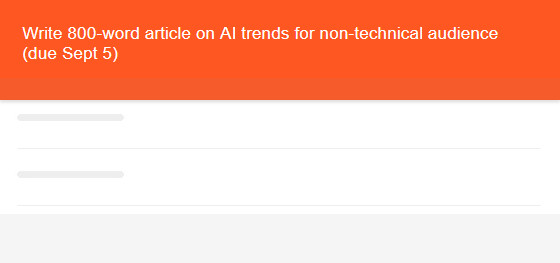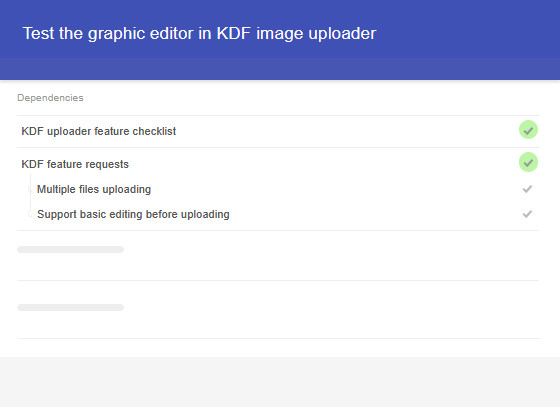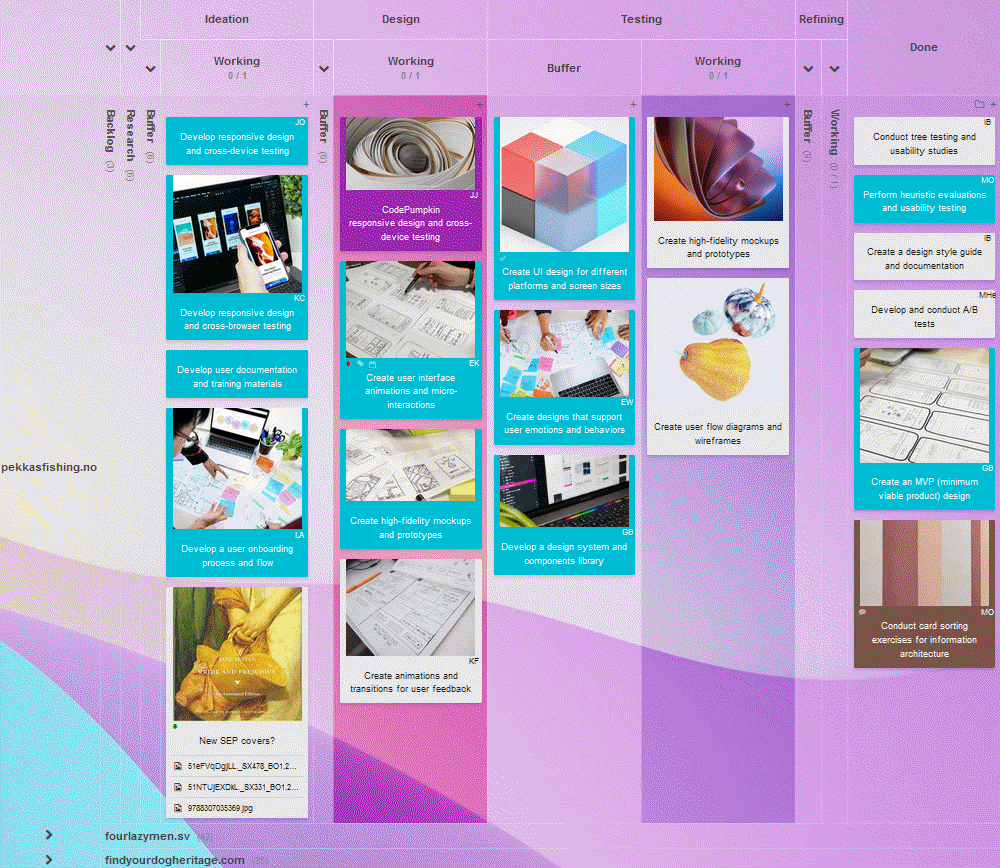Perfecting the Kanban Card Design to Make Every Task Clear, Actionable, and Traceable10 Dec 2025

Teamworking ability aside, a team's Kanban board can only be as effective as its cards. In a way, treating the cards as mere to-do items or scribbled reminders wastes the power of the system. A thoughtfully constructed card should represent a task along with the intent, scope, next steps, and status of the work. Getting the card design right can transform your board from a passive tracker into a dynamic system for controlling work.
Below is a practical breakdown of the components of an effective Kanban card design.
Clarity
A strong Kanban card should eliminate ambiguity, even for someone unfamiliar with the context. Consider if the card provides enough information for someone to take it over without any additional clarification:
- Use structured summaries: Start with a concise statement of intent, e.g., Draft Q3 email campaign outline for review, as opposed to a vague titles such as Email plan or Q3 project that assume the reader knows exactly what the title refers to.
- Embed scope: Put the critical parameters into the description. Instead of Write article, be specific: Write 800-word article on AI trends for non-technical audience (due Sept 5).
- Contextual links: Link to supporting documents or tasks, rather than assuming team members know where to find background materials.
- The point of being clear isn’t to be verbose. The aim is to frontload the information that answers what, why, how, and for whom - not to write long paragraphs for the sake of appearing thorough.

Actionability
Kanban tasks should always imply motion, suggesting and inviting a specific action. This is where many teams fall short, their cards state what the outcome might be, but not what the next steps towards it are.
- The card title should start with an action-inducing verb: review, update, implement, design, write, test, etc.

- Tasks that can’t be acted on directly should be broken down. Finalize launch plan is likely too large, but if the first step is Collect feedback from marketing, it might become a separate card, or at least a subtask of the parent item.
- Identify blockers and dependencies within the card, not in your head.
- The best test of whether a task is actionable is whether the assignee can move it to “Done” without asking for help and clarification.
Traceability
A card that sits in isolation invites confusion: where did it come from, why is it being prioritized, who requested it? Without traceability, the team loses the ability to answer these questions quickly during triage or reviews. Well-documented and linked cards can change project and performance reviews from a forensic exercise to a straightforward analysis.
- Tagging conventions: Use consistent tags to indicate project, initiative, client, or sprint - whatever works for the situation. E.g., [Q3_Campaign], [Feature:Search], [Client:WayfarerBank].
- Link upstream/downstream work: Use the card description, the dependencies area, or comments to point to related cards (designs feeding into dev, dev feeding into QA, etc.), thereby offering a complete picture of the work.

- Origin notes: Add a line about where the card came from. Example: Created from client feedback in the demo meeting on July 18. If there is a limited and repeatable set of sources, use a dropdown with those options instead.
Checklists
Tasks split into multiple steps need a unified understanding of “done”. Without a binary checklist status, you're either relying on memory or enforcing rules through meetings. A working checklist should do more than just itemize, it should define quality.
- Consider grouping to-do items by category, rather than chronology; why create linear checklists that assume order in cases where the order doesn't matter? Instead, group by function, e.g., design, content, review.
- Define completion standards in non-ambiguous terms; instead of Get approval, use Approval received from legal in writing.
- Avoid checklist bloat. If there are going to be more than ten items, reassess whether the task would be more manageable broken into several cards. Think of the checklist as a compact operating manual for completing the work, not a dumping ground for everything someone might remember as potentially relevant.
Naming conventions
Inconsistent naming can subtly diminish productivity and motivation. It breaks all searches, ruins filtering, and makes historical reviews harder. Make an effort to design your card titles and tags according to a set convention, not fluid vibes. Consider using conventions like these:
- Title format: [Type] Verb + Object + Outcome.
Example: [Dev] Build endpoint for new login flow. - Date tags: Use YYYY-MM-DD format for temporal sorting.
Example: [2025-08-03] instead of beginning of August or Q3. - Effort/difficulty signals (if used): [S], [M], [L], 1-10, or T-shirt sizes. The point is to ensure that the definitions are documented and used consistently across a project.
- Owner vs. current handler (assignee): Decide how you're denoting the final-say responsible party, especially if this person is not the same as the task doer/assignee. Use tags, custom user dropdowns, or task colors if needed.
The payoff
When cards are clear, consistent, and traceable, your Kanban board upgrades from being a static snapshot into a living map of the work ecosystem. Stand-ups can become minimal because the card's status speaks for itself, hand-offs get easier because no one has to guess what to do next, and reviews become smarter because you can trace each decision back to its source.

An intentional card design should be part of how teams think together in distributed systems. Think of each card as a compact, autonomous agent in your process architecture; built well, they can work for you, not against you!
Automating Cyclical Work in Kanban for Higher Efficiency12 Nov 2025
In a typical knowledge-based work scenario, managing a Kanban board 100% manually works OK for the first few weeks — until one too many recurring task slips through the cracks, someone forgets to compile a weekly report, and you're knee-deep in reviewing items you already reviewed last Thursday....
Dynamic Kanban — Designing Adaptive Boards for Changing Priorities13 Oct 2025
Visual clarity and simplicity are some of Kanban boards' core strengths, but what if the clarity turns into rigidity? When workflows mutate — whether due to shifting priorities, unexpected bottlenecks, or evolving product goals — a static board can silently start to erode team efficiency....
Supporting Concurrent Project Streams with Kanban09 Sep 2025
When a team runs concurrent project streams—whether in software, marketing, research, or operations—work visibility can degrade rapidly. Although Kanban offers a simple framework made of columns, cards, and their flow tracking, if left naïvely configured, a single Kanban board can easily...
Micro Policies Guiding Macro Benefits in Team Workflow05 Aug 2025
There is a particular kind of momentum that drives high-functioning teams. It rarely emerges from talent alone, but rather comes from a well-thought-out structure rich with detail — specifically, detail that's intentionally minimal, deliberately enforced, and mutually understood. Talking...
Using Kanban to Improve Decision-Making and Accelerate Alignment28 Jul 2025
Making a decision is rarely a solitary moment of clarity amid chaos. Most decisions emerge from a context web, shaped by the clarity of available information, the visibility of conflicting demands, and the confidence that priorities are understood across a team. However, Kanban—the simple...
How Kanban Clears the Mind17 Jul 2025
By distilling work into ordered, visible, manageable units, Kanban taps into fundamental principles of cognitive psychology. Having tasks organized in neat piles in front of you can restructure how your mind interacts with work itself. At its core, Kanban is a system of constraints— it's...
Boosting Team Transparency and Accountability with Kanban09 Jul 2025
Most teams reach for a system like Kanban not because they crave another whiteboard or web service. It's because they're frustrated—by blurry responsibilities, missed deadlines, and an endless loop of status meetings that don't seem to clarify much. A properly implemented Kanban is more than...
Mastering Flow as the Key to a Smoother Kanban System01 Jul 2025
Adopting Kanban as a visual management system often brings teams an initial sense of control: the work is visible, processing limits set, and the team feels more “agile”. But underneath the comfort of task cards and swimlanes lies a deeper challenge—ensuring that work items aren't just moved,...
Getting Kanban Right From Day One23 Jun 2025
The appeal of a Kanban board is immediate: a clean visual workflow, where sticky notes gracefully glide from To Do to Done, bringing a sense of structure without the rigidity of Gantt charts or traditional project plans. However, for Kanban newcomers, the elegance of the board can mask subtle...
Get started with Kanban Tool
Sign Up![]() Follow us on Twitter
Follow us on Twitter
![]() Join us at Facebook
Join us at Facebook
![]() Follow us on LinkedIn
Follow us on LinkedIn
![]() Subscribe via RSS
Subscribe via RSS